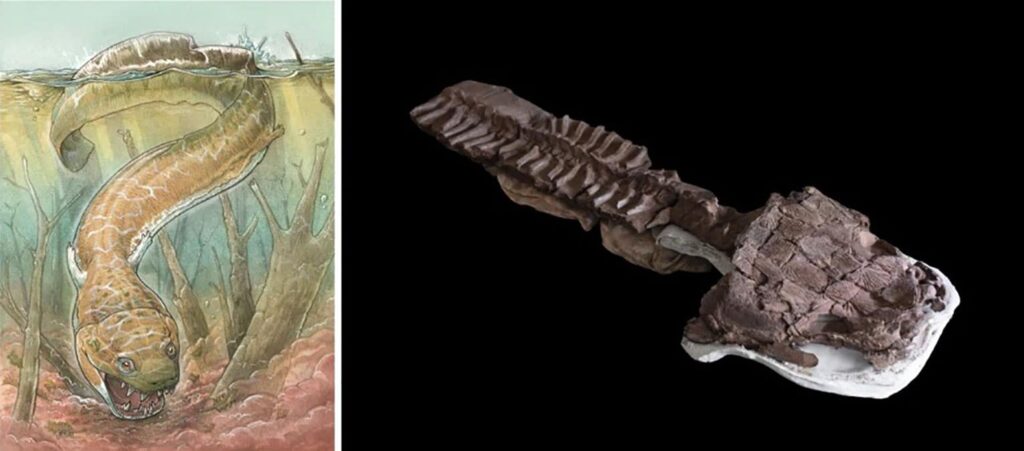Forty million years before the emergence of dinosaurs, there existed a fierce predator that dwelled in marshy areas. With a skull measuring over two feet in length, it patiently waited with its jaws wide open, ready to seize any unsuspecting prey that crossed its path. Introducing Gaiasia Jennyae, the creature of the swamp with a head resembling a toilet seat.
“Gaiasia jennyae was considerably larger than a person, and it probably hung out near the bottom of swamps and lakes. It’s got a big, flat, toilet seat-shaped head, which allows it to open its mouth and suck in prey. It has these huge fangs; the whole front of the mouth is just giant teeth,” says Jason Pardo, an NSF postdoctoral fellow at the Field Museum in Chicago and the co-lead author of the Nature study. “It’s a big predator, but potentially also a relatively slow ambush predator.”
The Gai-as Formation in Namibia, where the fossil was discovered, gives the fossil its name. It is also named after Jenny Clack, a paleontologist who focused on early tetrapod evolution, which refers to the four-limbed vertebrates that originated from lobe-finned fishes and eventually led to the development of amphibians, reptiles, birds, and mammals.
The fossil was uncovered by Claudia Marsicano of the University of Buenos Aires and her colleagues, who are co-authors alongside Pardo.
“When we found this enormous specimen just lying on the outcrop as a giant concretion, it was really shocking. I knew just from seeing it that it was something completely different. We were all very excited,” said Marsicano. “After examining the skull, the structure of the front of the skull caught my attention. It was the only clearly visible part at that time, and it showed very unusually interlocking large fangs, creating a unique bite for early tetrapods.”
The research team discovered multiple specimens, including one containing a well-preserved, articulated skull and spine.
“When we found this enormous specimen just lying on the outcrop as a giant concretion, it was really shocking. I knew just from seeing it that it was something completely different. We were all very excited,” said Marsicano. “After examining the skull, the structure of the front of the skull caught my attention. It was the only clearly visible part at that time, and it showed very unusually interlocking large fangs, creating a unique bite for early tetrapods.” It appears that this animal has many distinctive features.
Namibia, which is currently situated just north of South Africa, was located even further south 300 million years ago. Specifically, it was close to the 60th parallel, nearly aligning with the current northernmost point of Antarctica. At that time, the Earth was approaching the conclusion of an ice age. The swampy terrain located close to the Equator was drying up and transforming into more forested areas, while closer to the poles, the swamps persisted, possibly alongside pockets of ice and glaciers.
In the hotter, less humid regions of the globe, animals were adapting and evolving into new species. Early four-legged vertebrates, known as stem tetrapods, diversified and divided into lineages that would eventually give rise to mammals, reptiles, and amphibians. However, on the outskirts, in places like present-day Namibia, more primitive forms persisted.
“Gaiasia is a stem tetrapod – it’s a holdover from that earlier group before they evolved and split into the groups that would become mammals and birds and reptiles and amphibians, which are called crown tetrapods,” says Pardo. “It’s really, really surprising that Gaiasia is so archaic. It was related to organisms that went extinct probably 40 million years prior.”
Moreover, for an oddball holdover from an even more ancient time, Gaiasia seemed to be doing pretty well for itself. “There are some other more archaic animals still hanging on 300 million years ago, but they were rare, they were small, and they were doing their own thing,” says Pardo. “Gaiasia is big, and it is abundant, and it seems to be the primary predator in its ecosystem.”
Furthermore, Gaiasia jennyae, although only a single species, provides valuable insights for paleontologists examining global changes during the Permian period.
“It tells us that what was happening in the far south was very different from what was happening at the Equator. And that’s really important because there were a lot of groups of animals that appeared at this time, and we don’t really know where they came from,” says Pardo. “The fact that we found Gaiasia in the far south tells us that there was a flourishing ecosystem that could support these very large predators. The more we look, the more we might find more answers about these major animal groups that we care about, like the ancestors of mammals and modern reptiles.”
Journal reference:
Claudia A. Marsicano, Jason D. Pardo, Roger M. H. Smith, Adriana C. Mancuso, Leandro C. Gaetano & Helke Mocke. Giant stem tetrapod was apex predator in Gondwanan late Palaeozoic ice age. Nature, 2024; DOI: 10.1038/s41586-024-07572-0
>>> Read full article>>>
Copyright for syndicated content belongs to the linked Source : Tech Explorist – https://www.techexplorist.com/gaiasia-jennyae-swamp-creature-toilet-seat-shaped-head/85878/#utm_source=rss&utm_medium=rss&utm_campaign=gaiasia-jennyae-swamp-creature-toilet-seat-shaped-head
